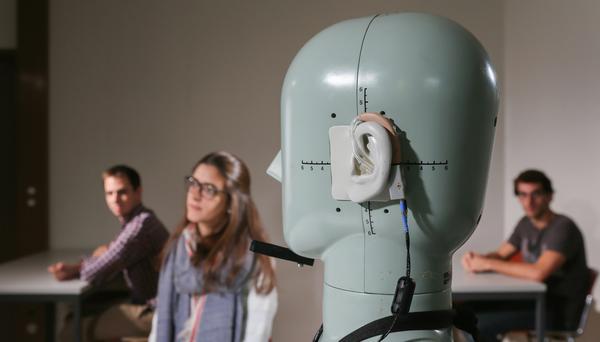Enabling Hearing impaired to locate the speaker

© 2014 EPFL/Alain Herzog
New wireless microphones systems developed at EPFL should allow the hearing impaired to aurally identify, even with closed eyes, the location of the person speaking. This new technology will be used in classrooms and conference rooms for better sound quality.
In the hubbub of a classroom or an auditorium, it can be difficult for a person who is hard of hearing clearly to understand what a teacher is saying, even with a hearing aid. A major cause of this is the difficulty of precisely identifying the location of the source of sounds. Based on that, a team of EPFL researchers has developed a new system of wireless microphones. They enable the wearer to locate where a speaker is in a room, even with closed eyes. This feature substantially improves the listening experience. Two prototypes have been developed as part of a CTI project - the Commission for Technology and Innovation - in partnership with the Fribourg company Phonak Communications AG.
Smarter system
For a person who does not suffer from any hearing impairment, localization is done automatically. Sound does not arrive at both ears at the same time, nor does it arrive in the same way. However, these subtle nuances are not transcribed in conventional systems with wireless microphones. As a result it is impossible for people who are hard of hearing to pinpoint the source of a sound, and this diminishes the listening quality.
EPFL researchers have found a way to configure the transmitted sound in each ear, so as to recreate the natural feel of listening artificially, in the context of a classroom or audience.
Calculating the sound equalization between the devices
Their prototype consists of hearing aids and wireless microphones. Specifically, they are composed of two conventional hearing aids with a microphone on each, and a computing system made specifically for localization and spatial information. Connected to each other, the hearing aids are placed behind the ears of the hearing impaired person. The speaker wears a clip-on microphone connected to a small box the size of a wallet. The voice is transmitted via radio waves.
"The built-in microphones in the hearing aid get the sound the moment it arrives, which is different for each ear," says Hervé Lissek, head of the acoustics group of the Electromagnetics and Acoustics Laboratory (LEMA) at EPFL. "We record both the sound received off the microphone, which is offset, and the sound transmitted via radio waves, which is homogeneous in both ears. This information allows us to deduce, via an algorithm, the position of the speaker and then to alter the sound accordingly," he adds. "The localization of sound in space is then simulated by playing with the phase, amplitude and intensity of the transmitted sound in each ear," says Gilles Courtois, PhD student in LEMA.
Genuine added value in terms of comfort and comprehensibility
The EPFL researchers' technology falls within the range of Roger products that are sold by Phonak, intended to be used both in traditional schools and in special schools for hearing-impaired children, but also for adult with hearing loss. In the classic version, the voice of the teacher is recorded by the microphone and transmitted uniformly to both ears, destroying any notion of spatiality. The new solution therefore brings genuine added value in terms of comfort and comprehensibility.
A pediatrics hearing care professional, Philippe Estoppey, who implements 30 to 40 hearing aids in French-speaking swiss classrooms, welcomes this innovation. "It is all the more interesting if more than one teacher is speaking", he says. "To hear a speaker correctly in a room, the first thing we do is to locate him or her. The body expression and the movements of the lips are helping in terms of intelligibility."
For the developers, the next step is to work on a final version of the device. "In the end, the system will be fully integrated. We will use the standard microphones of the hearing aids, and the processors of the prosthesis will make the calculations,", says Yves Oesch, project manager at Phonak Communications AG. "We are quite pleased with the results of this project. We now hope that we can continue working with EPFL towards the objective of marketing this new product in the future."